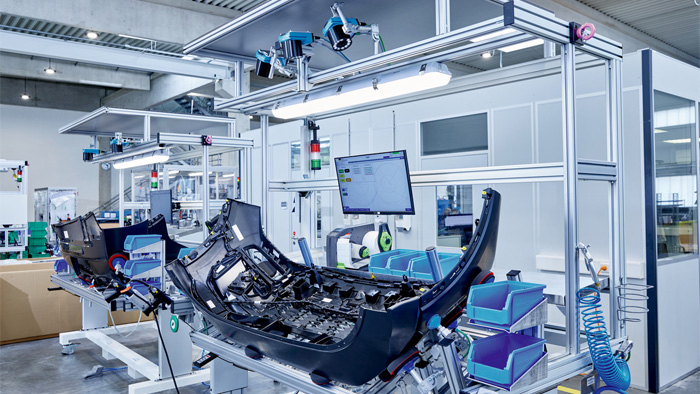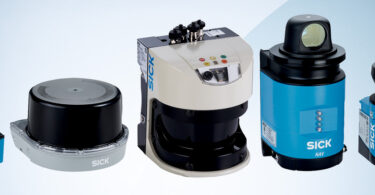Bumpers and beyond: SICK’s vision sensors set foundation for assembly facility’s inspection applications
Quality assurance through programmed imaging: this sounds like a job for SICK sensors and machine vision.
The German company RIBE Anlagentechnik develops innovative assembly systems, including inspection systems, for bumpers. SICK’s machine vision helps to identify the individual components, and it also monitors each work operation. This particular system concept could prove revolutionary for other manufacturers and suppliers as well.
As the level of individualization in production areas increases, so does the importance of special-purpose systems with innovative potential. RIBE Anlagentechnik specializes in delivering added value to its end customers. The company has demonstrated its specific strengths in technologies associated with assembly and inspection systems for vehicle interiors/exteriors and related components. Managing Director Dietmar Heckel regards the cobot and robot technologies with innovative Industry 4.0 solutions and digitalization concepts not only as a supporting pillar of RIBE Anlagentechnik, but also as a cross-sectoral growth field.
Componentized construction and its modular design have become fully standardized in recent years. According to Tobias Magg, Project Manager at RIBE, it’s become increasingly important to inspect individual components in assembly systems. That’s why they now offer a final assembly system for bumpers that checks, step by step, whether the correct parts for the specific bumper have been selected and mounted. The worker sees the result directly and clearly on the screen in front of them.
More individuality, more quality control
Whether it be backup cameras or windshield wiper systems, there are almost always multiple options available for a car model – and that means numerous bumper variants in different combinations.
“The potential for error in assembly is steadily increasing as a result,” stated Magg.
Every post-sale correction would not only be expensive, but also detrimental to the quality image of the manufacturer. In the early stages of his collaboration with RIBE, Walter Spiegel, sales engineer at SICK, called on the help of an application engineer. The aim was to literally illuminate the task.
“The key issue was: We needed to bring in more light,” Magg said in reference to the assembly system.
Many cameras that were first considered produced indistinct contrasts, which is not very helpful in a demanding and small part environment with dark parts on a black bumper background. The enormous light and visual sensitivity of the Inspector P642 2D vision camera was therefore one of the decisive factors for RIBE selecting the device.

Large camera distance covers a wide field
The camera is located at an adequate distance of 110 cm above the bumper on the workbench and outside the area where it could pose a hindrance. The worker can now install adapters, hoses, cameras, and other electronics on the inside of the bumper without any risk of bumping into the camera. Using just three cameras, a very large field of view is created looking down on the complete bumper. This is another reason why the issue of illumination was so important.
Magg pointed out the convenience this brings to his customers. “The standard sensor technology in the past required a large number of optic fibers or individual sensors,” or multiple cameras with backlighting and additional illumination units. The new solution is also flexible enough to cater to the following requirements.

From the left: Tobias Magg, Project Manager Mechanical Design at RIBE Anlagentechnik GmbH; Walter Spiegel, Regional Account Manager at SICK Vertriebs-GmbH.
Image-guided assistance with machine vision
Stefan Hochhäuser, Product Manager at SICK, was also involved in the project. “As soon as the worker moves away from the workbench to fetch the next component, he triggers an inspection of his work and thereby initiates the next work step,” Hochhäuser said.
The movements are detected by the small TiM100 2D LiDAR sensor which has a field of view of 200°. This compact sensor monitors the area in front of the assembly system and was a simple and cost-effective solution for RIBE, because it’s easy to integrate into the system and delivers stable measurements of the worker’s movements.

With the help of the triggering by the TiM100 2D LiDAR sensor and the InspectorP642, it’s possible to immediately detect whether the correct part has been properly installed. In the event of an error – indicated in red on the screen – the next work step cannot be initiated.
“If the inspection result is positive, the next step is displayed automatically to the worker,” Hochhäuser said. It is no coincidence, therefore, that the product was named “Inspector.”
Furthermore, each part takes about a minute to install for the worker, who wants to progress quickly and ergonomically. Thanks to the contactless job triggering, it no longer requires dozens of button presses to start and stop the camera. This saves seconds, which adds up to valuable time and cost savings over the course of a workday.

Precise in-sensor app for quality inspection with machine vision
A further prerequisite for higher productivity lies in the sensor itself, more specifically in its Quality Inspection App. It enables RIBE to configure a variety of inspection tasks in advance. For example, the sensor continuously checks whether the job was carried out correctly. This streamlines the programming in the PLC because the sensor signals the result to the controller via a TIA (Totally Integrated Automation) portal. This is displayed to the worker by color highlighting on the screen. In the case of a positive inspection, the task is switched or advanced. The app therefore makes it easier for customers to get started in image processing.
“The parameterization in the sensor makes it simple for us to create the inspection task in the vision sensor,” Magg said. It is theoretically possible to define up to 16 jobs (inspection tasks) in a single camera.
The SICK software is equally suitable for the smaller and larger vision cameras.
“If RIBE ever wants to implement the concept somewhere else, we don't have to change anything on the software side,” Hochhäuser said. “You can extract the parameters and easily transfer them to another device in the product family.”
The exciting thing about this solution is its general flexibility when it comes to future developments for other components and inspection tasks.
“We now have a foundation for further applications beyond assembling bumpers,” Magg said.
RIBE Anlagentechnik will also have the capability in the future to implement efficient manufacturing and quality inspection solutions based on SICK’s machine vision, thereby providing visibility beyond the controller screen alone.
Want to learn more about applications like this? Contact a SICK representative today!





